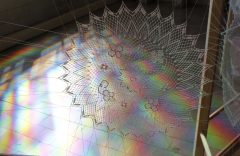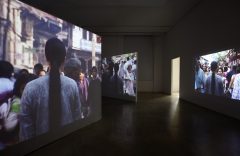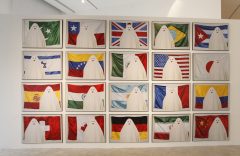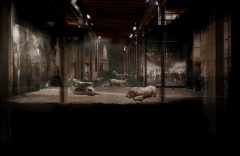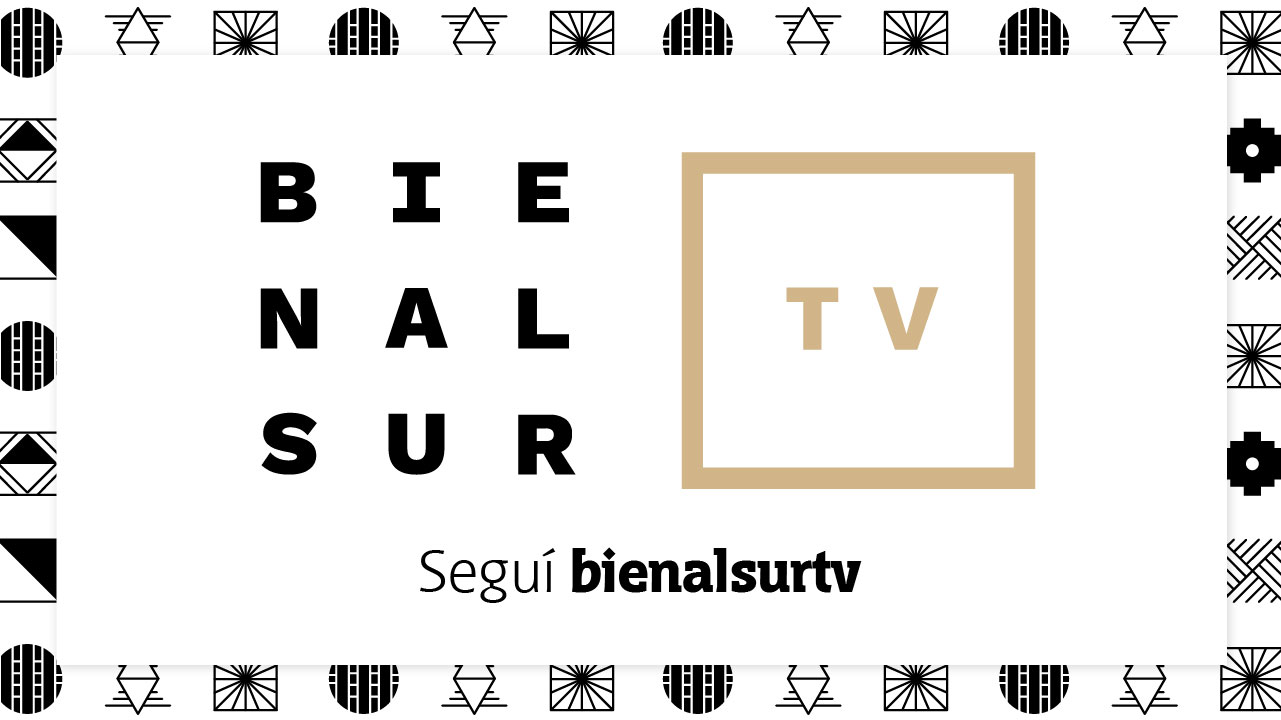
The platform is a window to the contemporary artistic-cultural scene. There, it is possible to see diverse exhibitions around the world. In August, the BIENALSUR cartography reached Europe and America.
BIENALSUR, created and produced by the National University of Tres de Febrero (UNTREF), launched the online channel BIENALSUR.TV, with free access and exclusive audiovisual content. This platform, dedicated to art, was developed by an audiovisual production team belonging to the University’s content producer, UNTREF Media, and content curatorship by Diana Wechsler, BIENALSUR’s Artistic Director. The content has been organized through different categories: Documentaries, Openings, Meetings, Dialogues, Thoughts and Projects. In all cases, these are BIENALSUR proposals that call for thinking, problematizing and taking a deeper look at the vital experiences of our time.
Those who visit the platform will be able to see more than 300 hours of audiovisual production, among the contents, the Global South dialogue meetings, held since 2015, and the virtual meetings towards BIENALSUR 2021, developed during 2020, where different figures of the contemporary artistic-cultural scene have been. Among them, the reference of cultural studies Néstor García Canclini, the Director of the Reina Sofía Museum of Spain; Manolo Borja; the curators Ralph Rugoff, Bartolomeo Pietromarchi and Ticio Escobar; the artists Martha Rosler and Voluspa Jarpa; and the artist Ali Kazma, among many others. It is a journey through various debates on topics such as art policies, art and social action, and art in public space, as well as the relationship between art and science, nature, transits and migrations, gender issues and memory, among other topics.
For the Rector of UNTREF and General Director of BIENALSUR, Aníbal Jozami, this project allows the expansion of community ties and pointed out that “far from imposing itself on cultures, institutions or groups, each edition goes through a unique cartography in which it seeks to listen, learn and work in a situated way without losing the global perspective. At BIENALSUR we promote art that is social and ensures the right to culture and diversity”.
On the launch of BIENALSUR.TV, Jozami stressed that it is one more example of the UNTREF and BIENALSUR’s ability to reach everyone, expanding and democratizing art audiences from various parts of the world. “Since the first edition, technology has allowed us to expand the map of art and to be able to visit different latitudes and points far from our extensive cartography at the same time. Today, with this channel and in tune with the times, we make quality content available to a wide audience that allows analysis of the contemporary art scene. This platform is a window to art that reaches new audiences, not only art lovers and fans but also those who consume cultural content exclusively in a digital manner, it is one more way to democratize it”.
BIENALSUR.TV also includes audiovisual pieces that show the behind-the-scenes of artistic projects, such as Turn, by Katsuhiko Hibino, which had the participation of communities from northern Argentina; and Images of my World, by Reza Deghati, which involved boys and girls from the Mugica neighborhood, two works linked to social inclusion.
In addition, you can get to know the backstage of works linked to nature, such as Memory of the Glacier, by Angelika Markul, and Mysteries, by Christian Boltanski, where both explore the Patagonian landscapes looking for an answer to the great existential dilemmas. The platform also presents previews of different exhibitions, interventions, performances and actions that will be part of BIENALSUR 2021.
On the other hand, users will find interviews with artists, curators, cultural managers, journalists and intellectuals from Argentina and the world where they reflect on contemporary art, its challenges and possible futures. There, for example, the contributions of Gilles Lipovetsky, Marcelo Dantas, Marim Karmitz, Michelangelo Pistoletto, Betsabée Romero, Gabriel Valansi, María Laura Rodríguez Mayol, Diana Gardeneira, Eduardo Basualdo and Claudia Coca stand out.
The sign offers tours of exhibition openings. BIENALSUR.TV is produced by a team made up of Santiago Camarda as General Producer and Ariel Germán Riveiro Díaz as Director, together with three editors, a journalistic producer and a cameraman.
Regarding the exhibition itself, several openings were held in our country and abroad during the month of August.
The first of these took place in Switzerland. On the 4th, the Parcours Culturel BIENALSUR Crans-Montana 2021 was inaugurated in Switzerland, a disturbing and unexpected exhibition that takes over public space, curated by Diana Wechsler, Artistic Director of BIENALSUR. The tension between nature and culture, between nature and society, is seen from the perspective of outstanding artists, including: Iván Argote, Pablo Reinoso, Marie Orensanz, Denis Savary, Katja Schenker, Christian de Belair and Agustina Woodgate; and includes a work and a tribute to the recently deceased Frenchman Christian Boltanski.
Also in Switzerland, but in the city of Lens, the Fondation Opale presented Breath of Life/Balambala, one of the most interesting exhibitions framed in the Ways of Living/Ecological Awareness curatorial axis, which combines traditional art forms and digital technologies of vanguard. Developed by Australia’s The Mulka Project, a collective of artists from Yirrkala, whose mission is to preserve and protect Yolŋu cultural heritage in northeast Arnhem Land, under the leadership of community elders.
The Canary Islands of Spain joined the inaugurations of the biennial with the exhibition Another order. Knocking down borders, curated by Diana Wechsler and exhibiting since August 28 at the Francis Naranjo Foundation.
The exhibition, which can be seen until the end of September, is part of the curatorial axes Politics of Art/Fluid Constellations, in line with the exhibition To the South of the South, which is exhibited in Malaga, Spain, and Together Apart, at the National Museum of Colombia, in Bogotá, and is also conceptually linked to another project that will be inaugurated in the Manzana de las Luces in the City of Buenos Aires, Argentina.
The forms of communication, the imposed distances, the new technologies, the world and its destiny, among other themes, appear in most of the works of the participating artists, from Spain, Brazil, Mexico, Chile, Peru, Italy, Argentina and Portugal.
Among the works, Integro, integro, integró –a short film by Argentines Gaby Messina and Ana Paula Penchaszadeh, with original music by the Oscar winner Gustavo Santaolalla, and sound by sound artist Juan Sorrentino– unveils a major program on Afro visibility in Argentina; while Louise Botkay, from Brazil, presents an experimental documentary made with Yanomani women from the Watorik community on the border between Brazil and Venezuela.
Promised Land, by the Peruvian Alfredo Ledesma Quintana, leads us to understand the concept of nature as being a generator and transmitter of knowledge; and Yendo, by the Argentinian Rodrigo Etem, allows you to take a tour of the American territory to discover the multiple resonance of the term progress, so associated with the Eurocentric concept of heading towards a space that others have imagined.
For its part, the Spanish collective Declinación Magnetica, made up of curators and visual artists, presents Margin de Error, which provides an interesting collective perspective; while the Chilean Nicolás Eduardo Cox Ascencio, in the photographic series Denial, takes hold, in different ways, of the idea of the flag.
Creators such as the Italian Rebecca De Marchi, the Portuguese Mónica de Miranda, the Brazilian Maíra Flores and the Spanish Gabriela Bettini, as well as the Mexican Gabriel Garcilazo and the Brazilian Ricardo Villa, return to themes that have made them known and also innovate in this international exhibition.
In addition, at the Museu Oscar Niemeyer, in Curitiba, Brazil, on August 5, inaugurated the installation made by the Brazilian artist Geraldo Zamproni, Vital Plots. Both in the use of materials and space, Geraldo’s works aim to visually alter the space that surrounds them, exploring the relationship between object, environment and observer. This intertwining produces an effect of estrangement and instability, a dialogue with the viewer that is sustained through the references inscribed in the work: everyday elements displaced from their scale, their use and habitat. Moving these elements to an unprecedented environment creates a new, exciting and very particular architecture.
In Brazilian territory but at the Federal University of Santa Maria, the exhibition FACTORS 8.0 – Digital propagation took place in situ and online. The tension between these different spaces generates new dimensions and challenges that the artists have gone through for months proposing, in many cases, dialogues and ruptures, frictions and expansions, also in the virtual environment. The exhibition travels these paths in which the on-site space absorbs and causes new reverberations in the online space. The pandemic –and all its experiences, consequences and damage– still moves and shocks society as a whole. In this context, the artists paved the way for proposing emergency exits that would allow them to think and reflect, activate and create, even stressing their own artistic languages.
Back in Argentina, the third edition of BIENALSUR saw the inauguration of Give and Give on August 20 with works by artists Aneta Bartos (POL/USA), Michael Dean (GBR), Leandro Katz (ARG), On Kawara (JPN), Nástio Mosquito (AGO), Oscar Murillo (COL), Otobong Ntanga (NGA), Yutaka Sone (JPN) and Gert Robijns (BEL) and Rirkrit Tiravanija (ARG/THA). Curated by Charlotte Crevits and Tommy Simoens, from Belgium, and registered within the curatorial axis Politics of Art, the launch took place at the Franklin Rawson Provincial Museum of Fine Arts, in the province of San Juan.
On August 21, also in San Juan, the exhibition Victor Grippo.An oven for two tables, curated by Carlos Godoy, was opened to the public at the Sarmiento Birthplace Museum and Library. The exhibition presents three works by the Argentine conceptual artist Víctor Grippo (1936-2002) that propose to reflect on food in times of crisis, the role of humanity against nature, that of citizens against the community, and that of producers of meaning in the face of an audience overwhelmed by urgency: Naturalize hunger, humanize nature (1977); The Artist’s Food (1991); and Construction of a popular oven to make bread (1972).
On August 27 and with Commoner Fantasies, the National Museum of Decorative Art, in the Errázuriz Palace, became the first institution in the Argentine capital to inaugurate an exhibition within BIENALSUR 2021, adding the Autonomous City of Buenos Aires among the more than 50 cities, 124 venues and 23 countries that are part of this 3rd edition known as the “Biennial of the art of resistance and resilience in times of pandemic” that began in July and will continue until December.
In Commoner Fantasies, Luciana Lamothe (Argentina), Gabriel Baggio (Argentina), Emil Finnerud (Norway) and Mehryl Levisse (France) are the artists who exhibit, under the curatorship of the Argentine Leandro Martínez Depietri, who asks himself in the curatorial words: “Why do we continue to look at the palaces of Buenos Aires with longing? The admiration of these architectures of opulence is usually accompanied by a feeling of decadence in the face of the present, imagining them as evidence of a glorious time that we lost. In this daydream that revives life in its halls and projects us into it, however, its original conditions of possibility are forgotten: the abysmal inequality between regions of the country and between social classes.
”Then we situate ourselves in the National Museum of Decorative Art, addressing the power of its evolution –from an aristocratic residence to a public museum– through a question: How to sustain an assessment of this heritage that can open the way to other desires and views? We rehearse possibilities from site-specific installations that dialogue with the history of the building and its collection in a playful way. They propose commoner fantasies through operations of construction, reconstruction and deconstruction that escape nostalgia for the belle époque. They invert signs, values and spatial logic, propose other design orders, highlight contrasts or push existing stylistic inconsistencies to the point of kitsch. These diverse strategies allow us to critically review heritage, expanding the enjoyment that ornamental exuberance produces in us towards new horizons of collective imagination”.
The exhibition was presented at BIENALSUR 2021 with the support of the Cultural Heritage Secretariat of the National Ministry of Culture. Accompanying the presentation of the Norwegian artist Emil Finnerud: Nordisk Kultur Fond (NKF) and Office for Contemporary Art Norway (OCA); of the French artist Mehryl Levisse: the Embassy of France in Argentina, the Institut Francais and the French Alliance; and the Argentine artist Luciana Lamothe: Atilio Bugliotti.
The August openings extended until the 28th, at MUNAR, in La Boca, also in the Autonomous City of Buenos Aires, with the exhibition of the Argentine artist, Alejandra Fenochio, curated by Charly Herrera.
News
